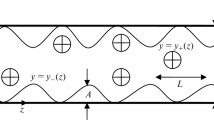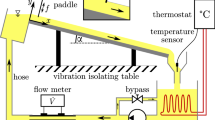Abstract
To settle the Engelund–Fredsøe channel-stability problem, a condition is defined in this paper which makes it possible to determine the value of the phase shift between the flow rate of the sediment load and the maximum of the bottom tangential stresses arising in a turbulent hydrodynamic flow when it flows around gentle shallow periodic waves of low steepness. The dependence of the phase shift for bottom waves of small steepness on the geometric and physicomechanical parameters of the problem is analyzed. For the distribution of shear stresses on the bottom surface, a regularity is established that relates the length of bottom waves to the depth of flow. This pattern generalizes a number of previously obtained phenomenological models and is consistent with known experimental data.


Similar content being viewed by others
REFERENCES
G. Fromant, D. Hurther, J. van der Zanden, D. A. van der A, I. Cáceres, T. O’Donoghue, and J. S. Ribberink, “Wave boundary layer hydrodynamics and sheet flow properties under large-scale plunging-type breaking waves,” J. Geophys. Res.: Oceans 124, 75–98 (2018).
M. Vah, A. Jarno, S. Le Bot, Y. Ferret, and F. Marin, “Bedload transport and bedforms migration under sand supply limitation,” Environ. Fluid Mech. (2020). https://doi.org/10.1007/s10652-020-09738-6
R. S. Mieras, J. A. Puleo, D. Anderson, T. -J. Hsu, D. T. Cox, and J. Calantoni, “Relative contributions of bed load and suspended load to sediment transport under skewed asymmetric waves on a sandbar crest,” J. Geophys. Res.: Oceans 124, 1294–1321 (2019).
C. Di Cristo, M. Iervolino, and A. Vacca, “Linear stability analysis of a 1-D model with dynamical description of bed load transport,” J. Hydraul. Res. 44, 480–487 (2006).
J. F. Kennedy, “The mechanics of dunes and antidunes in erodible–bed channels,” J. Fluid Mech. 16 (4), 521–544 (1963).
K. V. Grishanin, Stability of River Beds and Channels (Gidrometeoizdat, Leningrad, 1974) [in Russian].
A. G. Petrov and I. I. Potapov, Selected Chapters on Channel Dynamics (Lenand, Moscow, 2019) [in Russian].
M. A. Velikanov, Dynamics of Channel Flows (Gidrometeoizdat, Leningrad, 1949) [in Russian].
N. A. Mikhailova, “Mechanism of formation and movement of sand waves,” Izv. Akad. Nauk SSSR, Ser. Geofiz., No. 1, 53–58 (1952).
K. I. Rossinskii and V. K. Debol’skii, River Alluvia (Nauka, Moscow, 1980) [in Russian].
B. A. Shulyak, Physics of Waves on the Surface of a Loose Bed or a Liquid (Nauka, Moscow, 1971) [in Russian].
N. T. Povalo-Shveikovskii, Statistical Methods in the Turbulence Theory: A Monograph (Akad. Nauk SSSR, Moscow, 1938) [in Russian].
K. V. Grishanin, Channel Flow Dynamics (Gidrometeoizdat, Leningrad, 1979).
B. F. Snishchenko, “Relation between the height of sand waves and the parameters of the river flow and bed,” Meteorol. Gidrol., No. 6, 84–90 (1980).
D. Koller, R. Manica, A. Borges, and J. Fedele, “Experimental bedforms by saline density currents,” Braz. J. Geol. 42 (2), 1–10 (2019).
Y. Kim, R. S. Mieras, Z. Cheng, D. Anderson, T.-J. Hsu, J. A. Puleo, and D. Cox, “A numerical study of sheet flow driven by velocity and acceleration skewed near-breaking waves on a sandbar using SedWaveFoam,” Coastal Eng. 152, 1–18 (2019).
T. B. Benjamin, “Shearing flow over a wavy boundary,” J. Fluid Mech., No. 6, 161–205 (1959).
F. Engelund and J. Fredsøe, “Sediment ripples and dunes,” Annu. Rev. Fluid Mech 14, 13–37 (1982).
A. G. Petrov and I. I. Potapov, “Simulation of turbulent flow over periodic bottom surface,” Izv. Atmos. Oceanic Phys. 53, 367–372 (2017).
J. Buckles, T. J. Hanratty, and R. J. Adrian, “Turbulent flow over large–amplitude wavy surfaces,” J. Fluid Mech. 140, 27–44 (1984).
B. F. Snishchenko, “On the calculation of sand hill length in open flows,” Meteorol. Gidrol., No. 2, 89–96 (1980).
A. B. Klaven and Z. D. Kopaliani, “On the relation between ridge length and the longitudinal size of large-scale turbulence elements,” Tr. Gos. Gidrol. Inst. No. 219, 19–24 (1974).
Funding
The study was financially supported by the Russian Foundation for Basic Research (project no. 18-05-00530 А) and performed as part of State Task no. AAAA-A20-120011690138-6.
Author information
Authors and Affiliations
Corresponding authors
Rights and permissions
About this article
Cite this article
Petrov, A.G., Potapov, I.I. On the Engelund–Fredsøe Channel-Stability Problem. Izv. Atmos. Ocean. Phys. 56, 373–377 (2020). https://doi.org/10.1134/S0001433820040088
Received:
Revised:
Accepted:
Published:
Issue Date:
DOI: https://doi.org/10.1134/S0001433820040088




